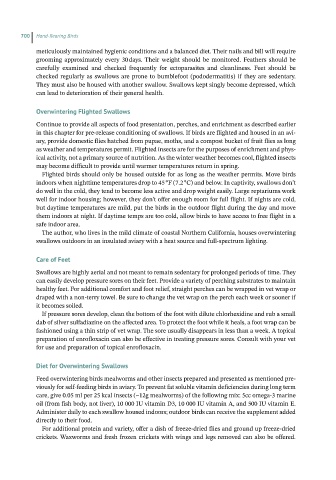Page 699 - Hand rearing birds second
P. 699
700 Hand-Rearing Birds
meticulously maintained hygienic conditions and a balanced diet. Their nails and bill will require
grooming approximately every 30 days. Their weight should be monitored. Feathers should be
carefully examined and checked frequently for ectoparasites and cleanliness. Feet should be
checked regularly as swallows are prone to bumblefoot (pododermatitis) if they are sedentary.
They must also be housed with another swallow. Swallows kept singly become depressed, which
can lead to deterioration of their general health.
OverwinteringFlightedSwallows
Continue to provide all aspects of food presentation, perches, and enrichment as described earlier
in this chapter for pre‐release conditioning of swallows. If birds are flighted and housed in an avi-
ary, provide domestic flies hatched from pupae, moths, and a compost bucket of fruit flies as long
as weather and temperatures permit. Flighted insects are for the purposes of enrichment and phys-
ical activity, not a primary source of nutrition. As the winter weather becomes cool, flighted insects
may become difficult to provide until warmer temperatures return in spring.
Flighted birds should only be housed outside for as long as the weather permits. Move birds
indoors when nighttime temperatures drop to 45 °F (7.2 °C) and below. In captivity, swallows don’t
do well in the cold, they tend to become less active and drop weight easily. Large reptariums work
well for indoor housing; however, they don’t offer enough room for full flight. If nights are cold,
but daytime temperatures are mild, put the birds in the outdoor flight during the day and move
them indoors at night. If daytime temps are too cold, allow birds to have access to free flight in a
safe indoor area.
The author, who lives in the mild climate of coastal Northern California, houses overwintering
swallows outdoors in an insulated aviary with a heat source and full‐spectrum lighting.
Careof Feet
Swallows are highly aerial and not meant to remain sedentary for prolonged periods of time. They
can easily develop pressure sores on their feet. Provide a variety of perching substrates to maintain
healthy feet. For additional comfort and foot relief, straight perches can be wrapped in vet wrap or
draped with a non‐terry towel. Be sure to change the vet wrap on the perch each week or sooner if
it becomes soiled.
If pressure sores develop, clean the bottom of the foot with dilute chlorhexidine and rub a small
dab of silver sulfadiazine on the affected area. To protect the foot while it heals, a foot wrap can be
fashioned using a thin strip of vet wrap. The sore usually disappears in less than a week. A topical
preparation of enrofloxacin can also be effective in treating pressure sores. Consult with your vet
for use and preparation of topical enrofloxacin.
Dietfor OverwinteringSwallows
Feed overwintering birds mealworms and other insects prepared and presented as mentioned pre-
viously for self-feeding birds in aviary. To prevent fat soluble vitamin deficiencies during long term
care, give 0.05 ml per 25 kcal insects (~12g mealworms) of the following mix: 5cc omega-3 marine
oil (from fish body, not liver), 10 000 IU vitamin D3, 10 000 IU vitamin A, and 500 IU vitamin E.
Administer daily to each swallow housed indoors; outdoor birds can receive the supplement added
directly to their food.
For additional protein and variety, offer a dish of freeze‐dried flies and ground up freeze‐dried
crickets. Waxworms and fresh frozen crickets with wings and legs removed can also be offered.

